ARCHITECTURAL TOURIST ATTRACTION SITES IN ETHIOPIA – Fasil ghebbi, Gondar
Ethiopia, a land of ancient civilizations and rich cultural heritage, boasts architectural marvels that reflect its storied past. Among these, Fasil Ghebbi in Gondar stands out as a UNESCO World Heritage Site and a testament to Ethiopia's imperial legacy. Established by Emperor Fasilidas in the 17th century, this fortified royal enclosure in the heart of Gondar, once Ethiopia's capital, showcases a unique blend of local and foreign architectural influences. Known as the Camelot of Africa, Fasil Ghebbi's castles, palaces, and churches offer a glimpse into the grandeur of Ethiopia's Gondarine period.
Historical Context of Fasil Ghebbi
 Located in the Amhara National Regional State, approximately 750 km northwest of Addis Ababa, Gondar is nestled in Ethiopia's highlands at an elevation of over 2,000 meters. Before Gondar's establishment as Ethiopia's capital in 1636, Ethiopian emperors led a nomadic lifestyle, moving their royal camps across the country to maintain control and administer justice.
Located in the Amhara National Regional State, approximately 750 km northwest of Addis Ababa, Gondar is nestled in Ethiopia's highlands at an elevation of over 2,000 meters. Before Gondar's establishment as Ethiopia's capital in 1636, Ethiopian emperors led a nomadic lifestyle, moving their royal camps across the country to maintain control and administer justice. Emperor Fasilidas (Amharic: ፋሲለደስ; reigned 1632 - 1667) broke this tradition by founding Gondar and constructing Fasil Ghebbi, a permanent royal enclosure that solidified the city's status as the political and cultural heart of Ethiopia. Gondar served as Ethiopia's capital from 1636 until the mid-19th century, a period marked by architectural innovation and cultural flourishing known as the Gondarine era. Fasil Ghebbi, meaning "royal compound" in Amharic (ግቢ), was the epicenter of this transformation.
Enclosed by a 900-meter-long stone wall punctuated by 12 gates and three bridges, the compound housed palaces, libraries, and banqueting halls built by Fasilidas and his successors, including Emperors Yohannes I, Iyasu I, Dawit III, Bakaffa, Iyasu II, and Empress Mentewab. The site's enduring structures reflect Ethiopia�s imperial power and its engagement with global influences during the 17th and 18th centuries.
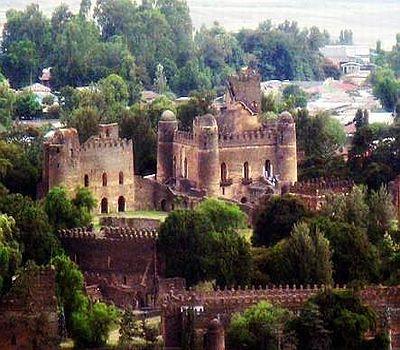
Architectural Significance of Fasil Ghebbi
Fasil Ghebbi's architecture is a remarkable fusion of Ethiopian traditions and foreign influences, particularly the Baroque style introduced by Jesuit missionaries and Portuguese artisans in the early 17th century. The compound'ss buildings feature rounded turrets, crenelated battlements, and arched doorways, blending local construction techniques, using stone and mortar with European-inspired designs. This syncretic style, unique to Gondar, sets Fasil Ghebbi apart from other African architectural sites of the period.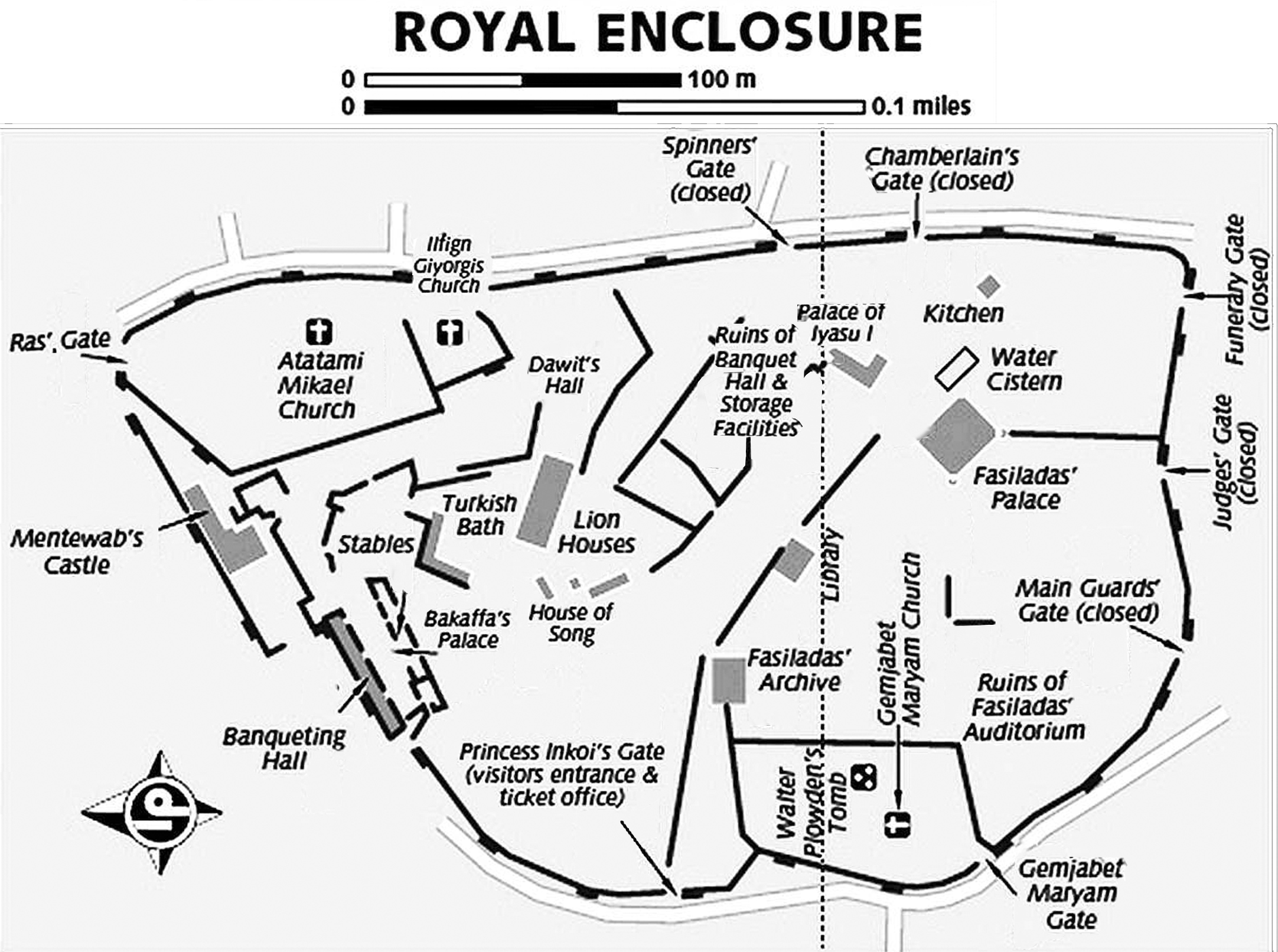 The 44-hectare compound includes several key structures, each with distinct architectural and historical significance:
The 44-hectare compound includes several key structures, each with distinct architectural and historical significance:
Castle of Emperor Fasilidas
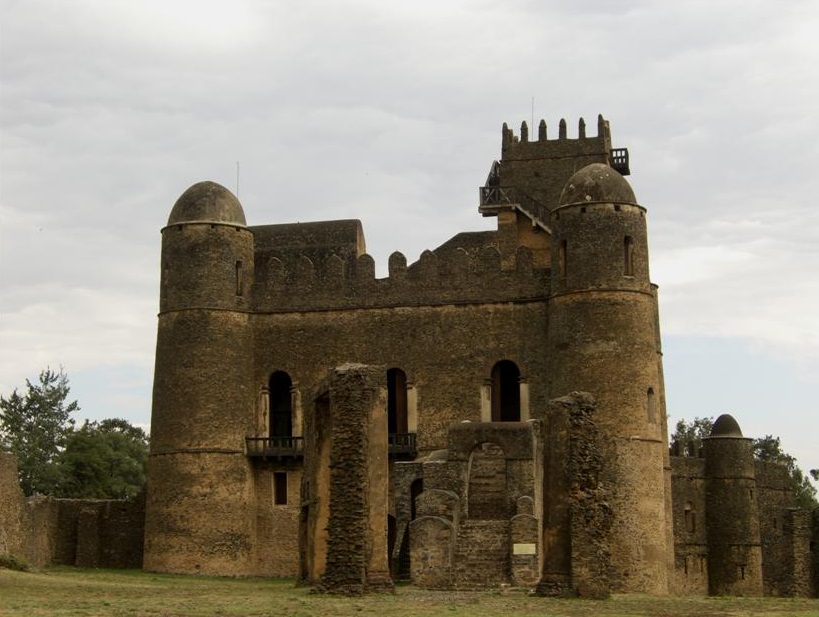 The centerpiece of Fasil Ghebbi, this two-story castle is Ethiopia's oldest and most iconic royal residence. Built in the 1630s, it features thick stone walls, four corner towers, and a central keep with a rooftop terrace offering panoramic views of Gondar. The interior includes spacious halls with arched ceilings and wooden beams, reflecting Baroque influences. The castle's robust design served both defensive and ceremonial purposes, symbolizing Fasilidas's authority.
The centerpiece of Fasil Ghebbi, this two-story castle is Ethiopia's oldest and most iconic royal residence. Built in the 1630s, it features thick stone walls, four corner towers, and a central keep with a rooftop terrace offering panoramic views of Gondar. The interior includes spacious halls with arched ceilings and wooden beams, reflecting Baroque influences. The castle's robust design served both defensive and ceremonial purposes, symbolizing Fasilidas's authority.
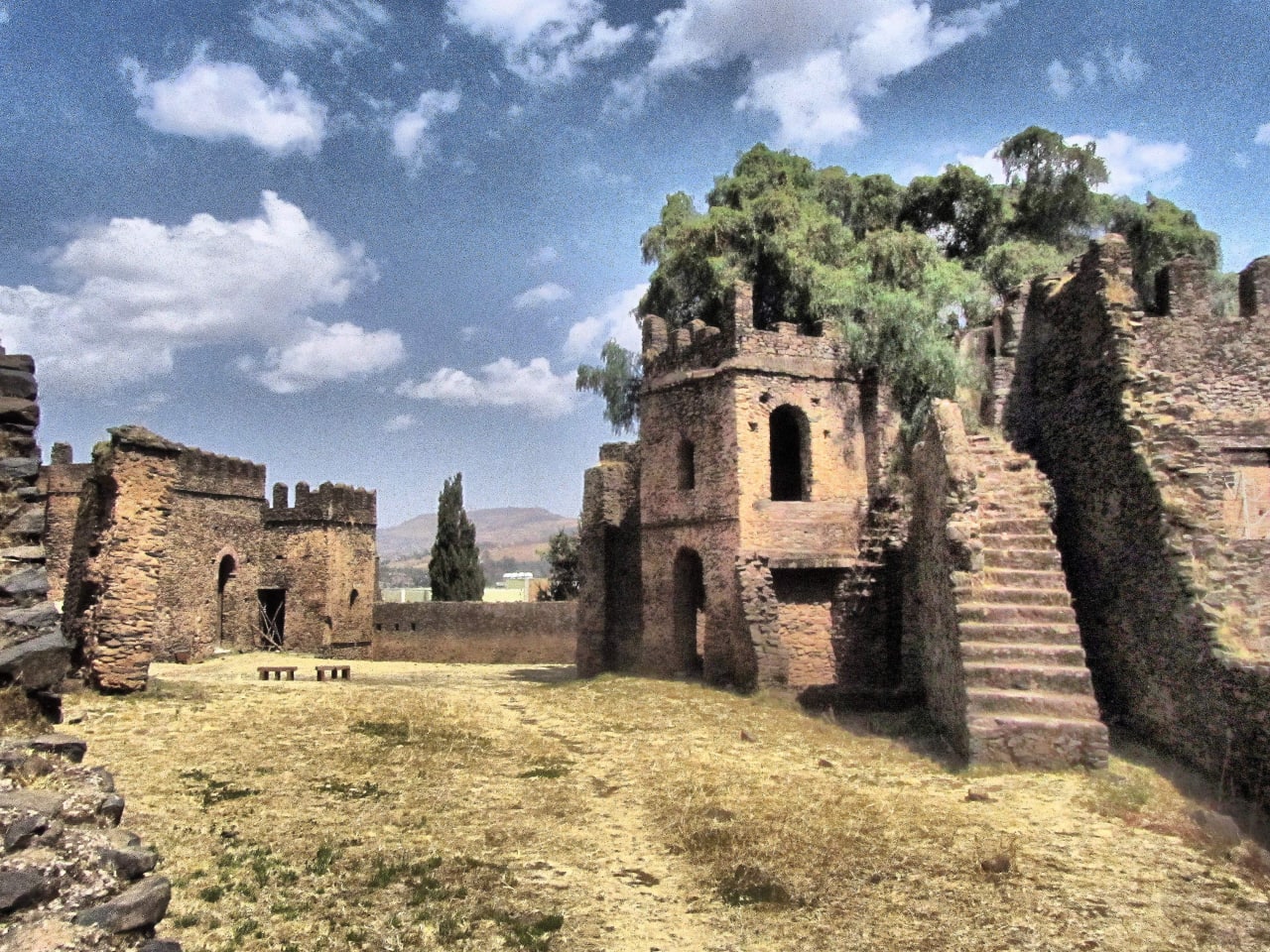 Known as the "Pearl of Gondar," Iyasu I's palace (reigned 1682-1706) is renowned for its ornate decoration and refined craftsmanship. The rectangular structure features intricate stonework, domed ceilings, and remnants of plasterwork with floral motifs. Its elegance reflects Iyasu's prosperous reign, during which Gondar reached its cultural zenith.
Known as the "Pearl of Gondar," Iyasu I's palace (reigned 1682-1706) is renowned for its ornate decoration and refined craftsmanship. The rectangular structure features intricate stonework, domed ceilings, and remnants of plasterwork with floral motifs. Its elegance reflects Iyasu's prosperous reign, during which Gondar reached its cultural zenith.
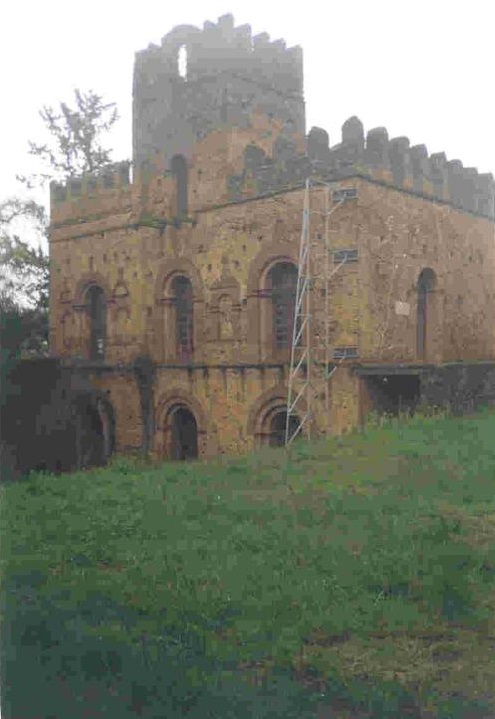 Built in the 1730s, this palace showcases a more delicate architectural style, with slender columns and arched windows. Mentewab, a powerful regent, used the palace as her residence and administrative center. Its proximity to the banqueting hall suggests its role in hosting state functions.
Built in the 1730s, this palace showcases a more delicate architectural style, with slender columns and arched windows. Mentewab, a powerful regent, used the palace as her residence and administrative center. Its proximity to the banqueting hall suggests its role in hosting state functions.
Banqueting Hall of Emperor Bakaffa
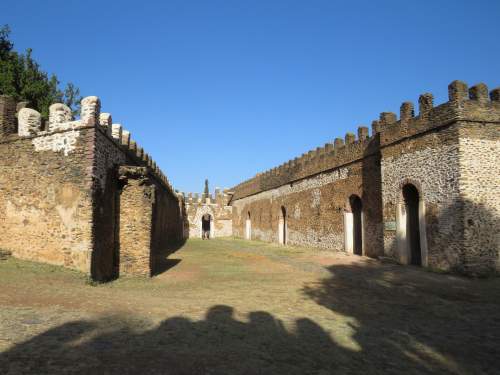 This expansive hall, attributed to Emperor Bakaffa (reigned 1721-1730), was used for lavish feasts and royal gatherings. Its large, open interior and high ceilings accommodated hundreds of guests, while its strategic location within the compound ensured security.
This expansive hall, attributed to Emperor Bakaffa (reigned 1721-1730), was used for lavish feasts and royal gatherings. Its large, open interior and high ceilings accommodated hundreds of guests, while its strategic location within the compound ensured security.
Library and Chancellery of Tzadich Yohannes
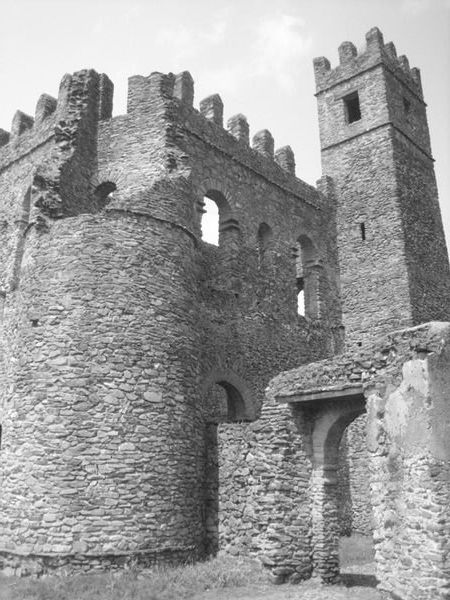 Emperor Yohannes I (reigned 1667-1682) constructed these buildings to store religious manuscripts and administer state affairs. The library, with its vaulted ceiling, housed illuminated Ge-ez texts, while the chancellery featured administrative offices, highlighting Gondar�s role as an intellectual hub.
Emperor Yohannes I (reigned 1667-1682) constructed these buildings to store religious manuscripts and administer state affairs. The library, with its vaulted ceiling, housed illuminated Ge-ez texts, while the chancellery featured administrative offices, highlighting Gondar�s role as an intellectual hub.
Castle of Emperor Dawit III
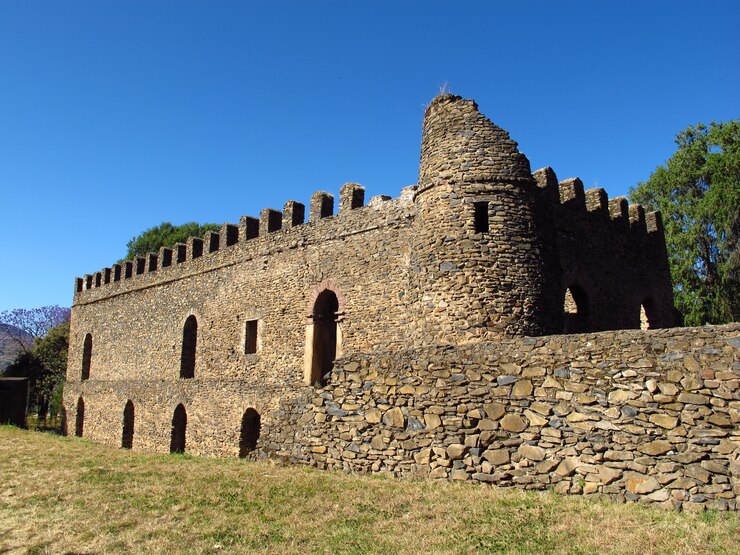 Built in the early 18th century, this smaller castle features a single tower and a fortified courtyard. Its simpler design reflects the declining resources of Dawit III's reign but retains the compound's characteristic stonework.
Built in the early 18th century, this smaller castle features a single tower and a fortified courtyard. Its simpler design reflects the declining resources of Dawit III's reign but retains the compound's characteristic stonework.
Additional Structures
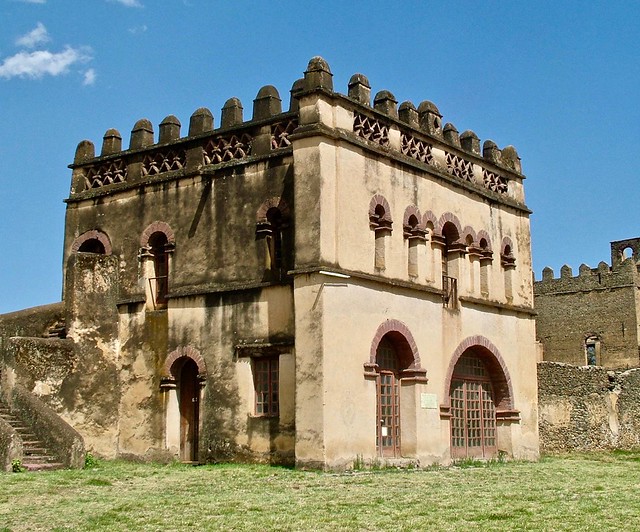 The compound also includes stables, a lion cage (where emperors kept lions as symbols of power), and water reservoirs. The 12 gates, each with a unique name and function (e.g., Qaha Gate for royal processions), and three stone bridges facilitated movement within the enclosure.
Beyond Fasil Ghebbi, Gondar's architectural legacy extends to nearby sites like the Debre Berhan Selassie Church, famous for its vibrant ceiling frescoes, and the Bath of Fasilidas, a tree-shaded pool used for Timkat (Epiphany) celebrations. These sites, often included in tours of Fasil Ghebbi, showcase Gondar's role as a religious and cultural center.
The compound also includes stables, a lion cage (where emperors kept lions as symbols of power), and water reservoirs. The 12 gates, each with a unique name and function (e.g., Qaha Gate for royal processions), and three stone bridges facilitated movement within the enclosure.
Beyond Fasil Ghebbi, Gondar's architectural legacy extends to nearby sites like the Debre Berhan Selassie Church, famous for its vibrant ceiling frescoes, and the Bath of Fasilidas, a tree-shaded pool used for Timkat (Epiphany) celebrations. These sites, often included in tours of Fasil Ghebbi, showcase Gondar's role as a religious and cultural center.
Cultural and Historical Importance
Fasil Ghebbi's designation as a UNESCO World Heritage Site in 1979 underscores its global significance. The compound not only represents Ethiopia's architectural ingenuity but also its resilience against external threats, including Ottoman and Sudanese invasions. During the 17th and 18th centuries, Gondar was a cosmopolitan hub, hosting Armenian, Indian, and Portuguese traders, as well as Jesuit missionaries.This cultural exchange shaped Fasil Ghebbi's eclectic style and enriched Gondar's artistic traditions, particularly in painting and manuscript illumination. The Gondarine period saw advancements in literature, music, and theology, with Fasil Ghebbi serving as a patron of these arts.
The compound's libraries preserved Ethiopia's Christian heritage, while its palaces hosted diplomatic summits and religious ceremonies. Despite periods of decline, including looting during the 19th-century Zemene Mesafint (Era of the Princes) and British bombardment in 1941 during World War II, Fasil Ghebbi remains a symbol of Ethiopia's enduring monarchy.
Visiting Fasil Ghebbi: Tips for Tourists
-
Getting There
Gondar is accessible via a 1-hour flight from Addis Ababa to Gondar Airport or a 12-hour bus journey through scenic highlands. Local taxis and bajaj (rickshaws) provide transport within the city. -
Best Time to Visit
Visit between October and March for mild weather (15-25 degrees Celsius). January's Timkat festival, featuring processions at Fasilidas's Bath, is a cultural highlight. -
Tour Options
Hire a licensed guide at the site (50-100 birr per hour) for historical insights. Group tours from Addis Ababa often include Fasil Ghebbi alongside Lalibela and Axum. -
Entry Fees
As of 2022, the entry fee for Fasil Ghebbi is approximately 200 birr for foreigners, with discounts for students. A single ticket covers the main compound and nearby sites like Debre Berhan Selassie. -
What to See
- Explore Fasilidas's Castle for its commanding views and robust architecture.
- Admire Iyasu I's palace for its decorative details.
- Visit Debre Berhan Selassie Church (2 km away) for its stunning frescoes.
- Attend a mock Timkat ceremony at Fasilidas's Bath (arranged by some tour operators).
-
Cultural Etiquette
Dress modestly (cover shoulders and knees) when visiting churches. Remove shoes before entering religious sites and ask permission before photographing locals. -
Nearby Attractions
- Simien Mountains National Park: A 3-hour drive from Gondar, this UNESCO site offers trekking and wildlife (e.g., gelada baboons).
- Kuskuam Church: A 10-minute drive from Fasil Ghebbi, this 18th-century church built by Empress Mentewab features serene grounds and historical artifacts.
-
Dining and Accommodation
- Try local dishes like doro wat (spicy chicken stew) or tibs (grilled meat) at restaurants like Four Sisters in Gondar.
- Stay at hotels like Goha Hotel for panoramic views or Lodge du Chateau for boutique charm near Fasil Ghebbi.













